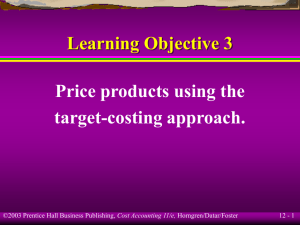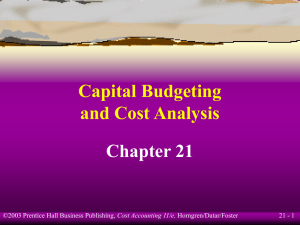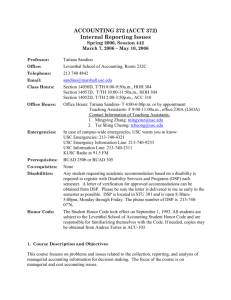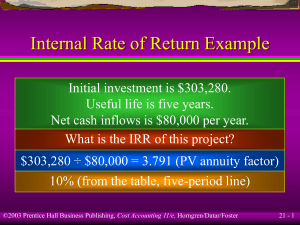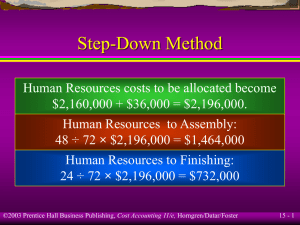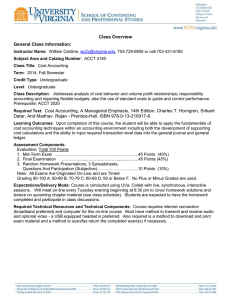Constant Gross-Margin Percentage NRV Method
advertisement
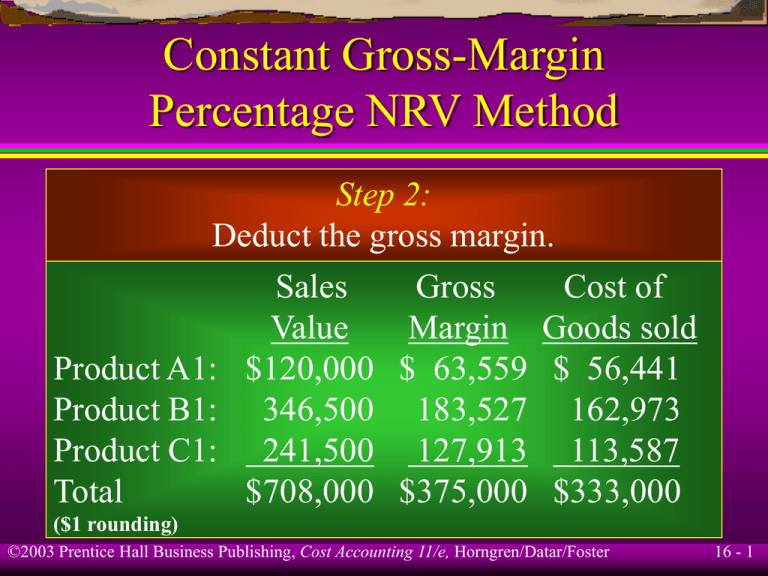
Constant Gross-Margin Percentage NRV Method Step 2: Deduct the gross margin. Sales Gross Cost of Value Margin Goods sold Product A1: $120,000 $ 63,559 $ 56,441 Product B1: 346,500 183,527 162,973 Product C1: 241,500 127,913 113,587 Total $708,000 $375,000 $333,000 ($1 rounding) ©2003 Prentice Hall Business Publishing, Cost Accounting 11/e, Horngren/Datar/Foster 16 - 1 Constant Gross-Margin Percentage NRV Method Step 3: Deduct separable costs. Cost of Separable Joint costs goods sold costs allocated Product A1: $ 56,441 $ 35,000 $ 21,441 Product B1: 162,973 46,500 116,473 Product C1: 113,587 51,500 62,087 Total $333,000 $133,000 $200,000 ©2003 Prentice Hall Business Publishing, Cost Accounting 11/e, Horngren/Datar/Foster 16 - 2 Approach 2: Physical Measure Method Example $200,000 joint cost 20,000 pounds A 48,000 pounds B 12,000 pounds C Product A $50,000 Product B $120,000 Product C $30,000 ©2003 Prentice Hall Business Publishing, Cost Accounting 11/e, Horngren/Datar/Foster 16 - 3 Learning Objective 5 Explain why the sales value at splitoff method is preferred when allocating joint costs. ©2003 Prentice Hall Business Publishing, Cost Accounting 11/e, Horngren/Datar/Foster 16 - 4 Choosing a Method Why is the sales value at splitoff method widely used? It measures the value of the joint product immediately. It does not anticipate subsequent management decisions. It uses a meaningful basis. It is simple. ©2003 Prentice Hall Business Publishing, Cost Accounting 11/e, Horngren/Datar/Foster 16 - 5 Choosing a Method The purpose of the joint-cost allocation is important in choosing the allocation method. The physical-measure method is a more appropriate method to use in rate regulation. ©2003 Prentice Hall Business Publishing, Cost Accounting 11/e, Horngren/Datar/Foster 16 - 6 Avoiding Joint Cost Allocation Some companies refrain from allocating joint costs and instead carry their inventories at estimated net realizable value. ©2003 Prentice Hall Business Publishing, Cost Accounting 11/e, Horngren/Datar/Foster 16 - 7 Learning Objective 6 Explain why joint costs are irrelevant in a sell-or-process-further decision. ©2003 Prentice Hall Business Publishing, Cost Accounting 11/e, Horngren/Datar/Foster 16 - 8 Irrelevance of Joint Costs for Decision Making Assume that products A, B, and C can be sold at the splitoff point or processed further into A1, B1, and C1. Selling Selling Additional Units price price costs 10,000 A: $10 A1: $12 $35,000 10,500 B: $30 B1: $33 $46,500 11,500 C: $20 C1: $21 $51,500 ©2003 Prentice Hall Business Publishing, Cost Accounting 11/e, Horngren/Datar/Foster 16 - 9 Irrelevance of Joint Costs for Decision Making Should A, B, or C be sold at the splitoff point or processed further? Product A: Incremental revenue $20,000 – Incremental cost $35,000 = ($15,000) Product B: Incremental revenue $31,500 – Incremental cost $46,500 = ($15,000) Product C: Incremental revenue $11,500 – Incremental cost $51,500 = ($40,000) ©2003 Prentice Hall Business Publishing, Cost Accounting 11/e, Horngren/Datar/Foster 16 - 10 Learning Objective 7 Account for byproducts using two different methods. ©2003 Prentice Hall Business Publishing, Cost Accounting 11/e, Horngren/Datar/Foster 16 - 11 Accounting for Byproducts Method A: The production method recognizes byproducts at the time their production is completed. Method B: The sale method delays recognition of byproducts until the time of their sale. ©2003 Prentice Hall Business Publishing, Cost Accounting 11/e, Horngren/Datar/Foster 16 - 12 Accounting for Byproducts Example Main Products Byproducts (Yards) (Yards) Production 1,000 400 Sales 800 300 Ending inventory 200 100 Sales price $13/yard $1.00/yard No beginning finished goods inventory ©2003 Prentice Hall Business Publishing, Cost Accounting 11/e, Horngren/Datar/Foster 16 - 13 Accounting for Byproducts Example Joint production costs for joint (main) products and byproducts: Material $2,000 Manufacturing labor 3,000 Manufacturing overhead 4,000 Total production cost $9,000 ©2003 Prentice Hall Business Publishing, Cost Accounting 11/e, Horngren/Datar/Foster 16 - 14 Accounting for Byproducts Method A Method A: The production method What is the value of ending inventory of joint (main) products? $9,000 total production cost – $400 net realizable value of the byproduct = $8,600 net production cost for the joint products ©2003 Prentice Hall Business Publishing, Cost Accounting 11/e, Horngren/Datar/Foster 16 - 15 Accounting for Byproducts Method A 200 ÷ 1,000 × $8,600 = $1,720 is the value assigned to the 200 yards in ending inventory. What is the cost of goods sold? Joint production costs Less byproduct revenue Less main product inventory Cost of goods sold $9,000 400 1,720 $6,880 ©2003 Prentice Hall Business Publishing, Cost Accounting 11/e, Horngren/Datar/Foster 16 - 16 Accounting for Byproducts Method A Income Statement (Method A) Revenues: (800 yards × $13) $10,400 Cost of goods sold 6,880 Gross margin $ 3,520 What is the gross margin percentage? $3,520 ÷ $10,400 = 33.85% ©2003 Prentice Hall Business Publishing, Cost Accounting 11/e, Horngren/Datar/Foster 16 - 17 Accounting for Byproducts Method A What are the inventoriable costs? Main product: 200 ÷ 1,000 × $8,600 = $1,720 Byproduct: 100 × $1.00 = $100 ©2003 Prentice Hall Business Publishing, Cost Accounting 11/e, Horngren/Datar/Foster 16 - 18 Journal Entries Method A Work in Process 2,000 Accounts Payable 2,000 To record direct materials purchased and used in production Work in Process 7,000 Various Accounts 7,000 To record conversion costs in the joint process ©2003 Prentice Hall Business Publishing, Cost Accounting 11/e, Horngren/Datar/Foster 16 - 19 Journal Entries Method A Byproduct Inventory 400 Finished Goods 8,600 Work in Process 9,000 To record cost of goods completed Cost of Goods Sold 6,880 Finished Goods 6,880 To record the cost of the main product sold ©2003 Prentice Hall Business Publishing, Cost Accounting 11/e, Horngren/Datar/Foster 16 - 20 Journal Entries Method A Cash or Accounts Receivable 10,400 Revenues 10,400 To record the sale of the main product ©2003 Prentice Hall Business Publishing, Cost Accounting 11/e, Horngren/Datar/Foster 16 - 21 Accounting for Byproducts Method B Method B: The sale method What is the value of ending inventory of joint (main) products? 200 ÷ 1,000 × $9,000 = $1,800 No value is assigned to the 400 yards of byproducts at the time of production. The $300 resulting from the sale of byproducts is reported as revenues. ©2003 Prentice Hall Business Publishing, Cost Accounting 11/e, Horngren/Datar/Foster 16 - 22 Accounting for Byproducts Method B Income Statement (Method B) Revenues: Main product (800 × $13) Byproducts sold Total revenues Cost of goods sold: Joint production costs 9,000 Less main product inventory 1,800 Gross margin ©2003 Prentice Hall Business Publishing, Cost Accounting 11/e, Horngren/Datar/Foster $10,400 300 $10,700 $ 7,200 $ 3,200 16 - 23 Accounting for Byproducts Method B What is the gross margin percentage? $3,200 ÷ $10,700 = 29.91% What are the inventoriable costs? Main product: 200 ÷ 1,000 × $9,000 = $1,800 By-product: -0- ©2003 Prentice Hall Business Publishing, Cost Accounting 11/e, Horngren/Datar/Foster 16 - 24 Journal Entries Method B Work in Process 2,000 Accounts Payable 2,000 To record direct materials purchased and used in production Work in Process 7,000 Various Accounts 7,000 To record conversion costs in the joint process ©2003 Prentice Hall Business Publishing, Cost Accounting 11/e, Horngren/Datar/Foster 16 - 25 Journal Entries Method B Finished Goods 9,000 Work in Process 9,000 To record cost of goods completed Cost of Goods Sold 7,200 Finished Goods 7,200 To record the cost of the main product sold ©2003 Prentice Hall Business Publishing, Cost Accounting 11/e, Horngren/Datar/Foster 16 - 26 Journal Entries Method B Cash or Accounts Receivable 10,400 Revenues 10,400 To record the sale of the main product Cash or Accounts Receivable 300 Revenues 300 To record the sale of the byproduct ©2003 Prentice Hall Business Publishing, Cost Accounting 11/e, Horngren/Datar/Foster 16 - 27 End of Chapter 16 ©2003 Prentice Hall Business Publishing, Cost Accounting 11/e, Horngren/Datar/Foster 16 - 28
